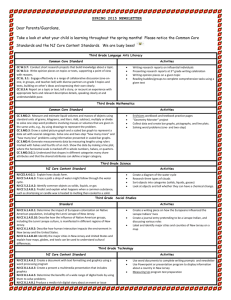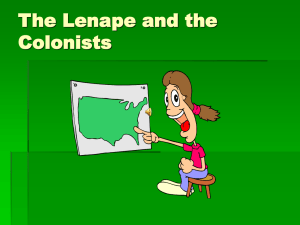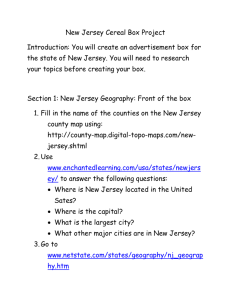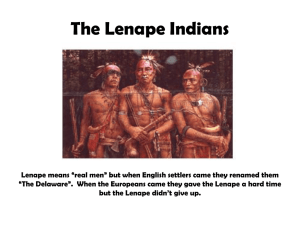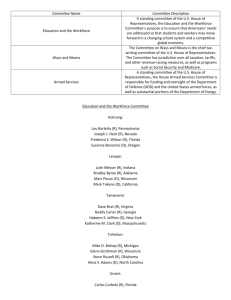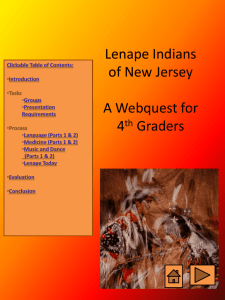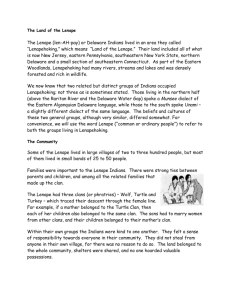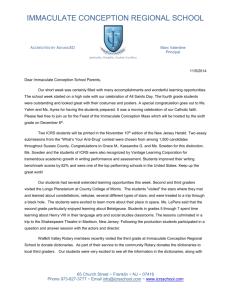Who are the Lenni Lenape Unit - New Jersey Center for Civic
advertisement
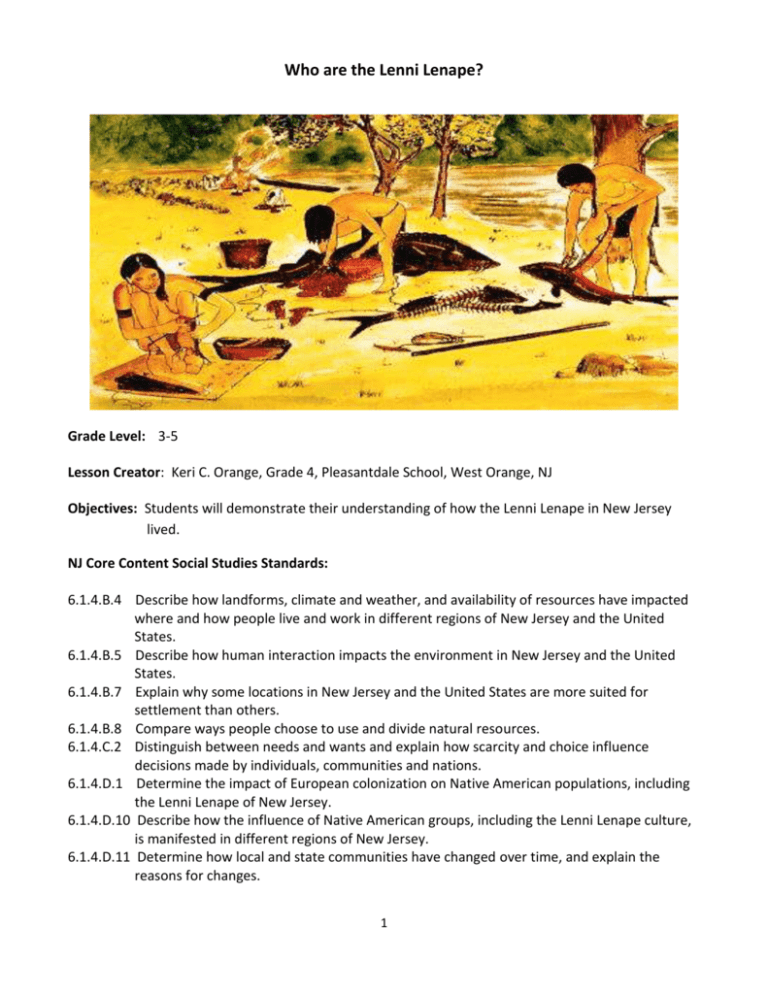
Who are the Lenni Lenape? Grade Level: 3-5 Lesson Creator: Keri C. Orange, Grade 4, Pleasantdale School, West Orange, NJ Objectives: Students will demonstrate their understanding of how the Lenni Lenape in New Jersey lived. NJ Core Content Social Studies Standards: 6.1.4.B.4 Describe how landforms, climate and weather, and availability of resources have impacted where and how people live and work in different regions of New Jersey and the United States. 6.1.4.B.5 Describe how human interaction impacts the environment in New Jersey and the United States. 6.1.4.B.7 Explain why some locations in New Jersey and the United States are more suited for settlement than others. 6.1.4.B.8 Compare ways people choose to use and divide natural resources. 6.1.4.C.2 Distinguish between needs and wants and explain how scarcity and choice influence decisions made by individuals, communities and nations. 6.1.4.D.1 Determine the impact of European colonization on Native American populations, including the Lenni Lenape of New Jersey. 6.1.4.D.10 Describe how the influence of Native American groups, including the Lenni Lenape culture, is manifested in different regions of New Jersey. 6.1.4.D.11 Determine how local and state communities have changed over time, and explain the reasons for changes. 1 Common Core ELA Standards: RI.4.2 Determine the main idea of a text and explain how it is supported by key details; summarize the text. RI.4.3 Explain…ideas or concepts in a historical…text RI.4.4 Determine the meaning of general academic and domain-specific words or phrases in a text RI.4.7 Interpret information presented visually, orally or quantitatively and explain how the information contributes to an understanding of the text in which it appears. RI.4.9 Integrate information from two texts on the same topic in order to write or speak about the subject knowledgeably. RI.4.10 Read and comprehend informational texts… W.4.2 Write informative/explanatory texts to examine a topic and convey ideas and information clearly W.4.4 Produce clear and coherent writing in which the development and organization are appropriate to task, purpose and audience W.4.7 Conduct short research project that builds knowledge through investigation of different aspects of a topic W.4.9 Draw evidence from …informational texts to support analysis, reflection and research SL.4.1 Engage effectively in a range of collaborative discussions (one-on-one…) SL.4.2 Paraphrase …information presented in diverse media,…including orally Essential/Focus questions: How does geography influence how people live? How did Native American of New Jersey and the Northeast region interact with the environment? Describe the ways in which Native Americans of the Northeast and Euro-Americans differed in how each group viewed and used the environment. How have landforms, climate and weather, and availability of resources impacted where and how people live and work in in New Jersey and the Northeast region? How do people make choices about using natural resources? (lumbering, shipbuilding, fishing and whaling, use of water power for textiles, farming, dairy farming) How does where people lived in the past influence how those people lived? How does where people live today influence how they live and what jobs they might do? How does where people live today influence how they live and what job they might do in different areas of the world today? How and why do people use and change the environment? How do people’s choices about how they use natural resources modify the environment? How does the type of community you live in (rural, urban, suburban) affect the way you interact with environment (five themes of geography)? What are the causes and effects of human movement to New Jersey and the Northeast region? How has transportation and innovations changed people’s use of the environment? Why is it important to take care of the earth? How do physical features of the land affect people and their use of the land? 2 How has the region changed overtime? What caused those changes? How and why have communities in New Jersey and the Northeast region changed over time, and explain the reasons for changes? What was life like for those who lived in the region long ago? Describe how the influence of the Lenni Lenape culture on different regions of New Jersey. What impact did European colonization have on Native American populations, including the Lenni Lenape of New Jersey, and the Northeast regions? What are a few turning points in the history of the region? What changed and what was the impact of those changes? How did science and technology help to change the region? When we retell the past (history), who’s story are we telling? What are primary sources and how do we use them to learn about the past/history? Procedures/Activities: Background Before European colonization, the New Jersey landscape was a mosaic of upland forests and shrublands, freshwater swamps and marshes, coastal plains inhabited by Lenni Lenapi Indians. You are a member of an archeology team that has been commissioned by the New Jersey Historic Trust Foundation to find and present information about the Lenni Lenape culture in New Jersey. Your information will be compiled into a magazine and the winning publication will be used in a new travel and tourism brochure for New Jersey! Good Luck with your research. May the best archeological team win! Each archaeologist is placed into a group and each group will research, design, and create a magazine on The Lenni Lenape Indians. Each member will do research and gather factual information on their assigned topic. As a group, it is your goal to find and share various aspects of the lives of the Lenape Indians during their early days in New Jersey. It is up to your group to select who will research each of the categories about the Lenni Lenape. Process: 1. Archaeologists will be assigned to a team/group by the teacher. 2. Each group will assign each member of your team one of the four topics to research: a. Food and Clothing: Group member #1 will find information about food and clothing of the tribe b. Location and Climate: Group member #2 will find information about location and climate of the tribe. c. Housing and Tools: Group member #3 will find information about housing tools of the tribe. d. Rituals and Customs: Group member #4 will find information about rituals and cultures of the tribe. e. Review the rubrics which will help you compile your information and design your presentations: Lenape Webquest Individual Participation Rubric Lenape Webquest Group Presentations Rubric 3 3. 4. 5. 6. 7. 8. f. Choose any one of the following graphic organizers to help you organize your notes: Lenape Webquest Notetaking Graphic Organizer 1 Lenape Webquest Notetaking Graphic Organizer 2 Lenape Webquest Notetaking Graphic Organizer 3 Lenape Webquest Notetaking Graphic Organizer 4 Use the resources and links to research information about your assigned topic. Take notes about the information you find. When you finish your research, return to your group to discuss your findings. Each person will complete a graphic organizer with their information. Each person is responsible for writing at least 2 paragraphs that describe the facts that are being presented for their category. You are to include at least 4 facts related to your category. These facts can be handwritten or typed in your own words with correct spelling, grammar and punctuation. Each person will also be responsible for having two pictures or illustrations to accompany their writing. Create a magazine, with each person submitting their information with illustrations Your group will give a presentation of your magazine and your findings. Resources/Links: 1. Food and Clothing http://www.usgennet.org/usa/nj/state/Lenape.htm http://www.bigorrin.org/lenape_kids.htm http://www.lenapelifeways.org/lenape1.htm 2. Location and Climate: http://www.usgennet.org/usa/nj/state/Lenape.htm http://www.bigorrin.org/lenape_kids.htm http://www.lenapelifeways.org/lenape1.htm 4 3. Housing and Tools: http://www.bigorrin.org/lenape_kids.htm http://www.lenapelifeways.org/lenape1.htm 4. Rituals and Customs: http://www.usgennet.org/usa/nj/state/Lenape.htm http://www.bigorrin.org/lenape_kids.htm http://www.lenapelifeways.org/lenape1.htm 5 Assessment: Individual Participation Rubric: Beginning Developing Accomplished Exemplary 1 2 3 4 Gathered Gathered Gathered three facts four facts Gathered one fact Gathered two facts Participation Making Magazine Hardly participated Participated slightly unsatisfactorily Included good photos and illustrations Included them, Included them and Did not include but they were not they tied into text them at all tying into the text well well Four Facts Participated very Participated a good much reflecting the amount highest level of performance. 6 Excellent choices that really flattered the piece. Score Spoke clearly Muffled, too during the soft, audience Presentation not able to hear reflecting a beginning level of performance. Some was clear, some not reflecting development and movement toward mastery of performance. Clear delivery of subject matter and good eye contact reflecting mastery of performance. Excellent delivery keeping audience very focused and interested reflecting the highest level of performance. Presented Description of enough Facts identifiable performance characteristics reflecting a beginning level of performance. Description of identifiable performance characteristics reflecting development and movement toward mastery of performance. Description of identifiable performance characteristics reflecting mastery of performance. Description of identifiable performance characteristics reflecting the highest level of performance. TOTAL Group Presentations Rubric: Oral Presentation Information Subject Knowledge Eye Contact Exemplary Accomplished Developing Beginning 4 points Well-balanced participation by all group members 3 points All group members have significant participation 2 points Most group members participate Student presents information in logical, interesting sequence which audience can follow. Subject knowledge is evident throughout. (more than required) All information is clear, appropriate, and correct. Student maintains eye contact with Student presents information in logical sequence which audience can follow. Audience has difficulty following presentation because student jumps around. Subject knowledge is evident in much of the product. Information is clear, appropriate, and correct. Some subject knowledge is evident. Some information is confusing, incorrect or flawed. 1 point One main speaker; little participation from other group members Audience cannot understand presentation because there is no sequence of information. Subject knowledge is not evident. Information is confusing, incorrect or flawed. Student maintains eye contact most of Student occasionally uses eye Student reads all of report with no eye 7 Score Elocution VISUALS Mechanics audience, seldom returning to notes. Student uses a clear voice and correct, precise pronunciation of terms so that all audience members can hear presentation. the time but frequently returns to notes. contact, but still reads most of report. contact. Student's voice is clear. Student pronounces most words correctly. Most audience members can hear presentation. Student's voice is low. Student incorrectly pronounces terms. Audience members have difficulty hearing presentation. Accurate, indepth information enhances presentation. Visually attractive, i.e. includes colorful pictures or diagrams, uses space well Presentation has no misspellings or grammatical errors. Information accurate; adequate visuals, but not very interesting. Most information accurate. Some pictures or diagrams, but poorly planned. Student mumbles, incorrectly pronounces terms, and speaks too quietly for students in the back of class to hear. Inaccurate information given. Very weak visual component Presentation has fewer than two misspellings and/or grammatical errors. Presentation has three or more misspellings and/or grammatical errors. Presentation has four or more spelling errors and/or grammatical errors. TOTAL 8
